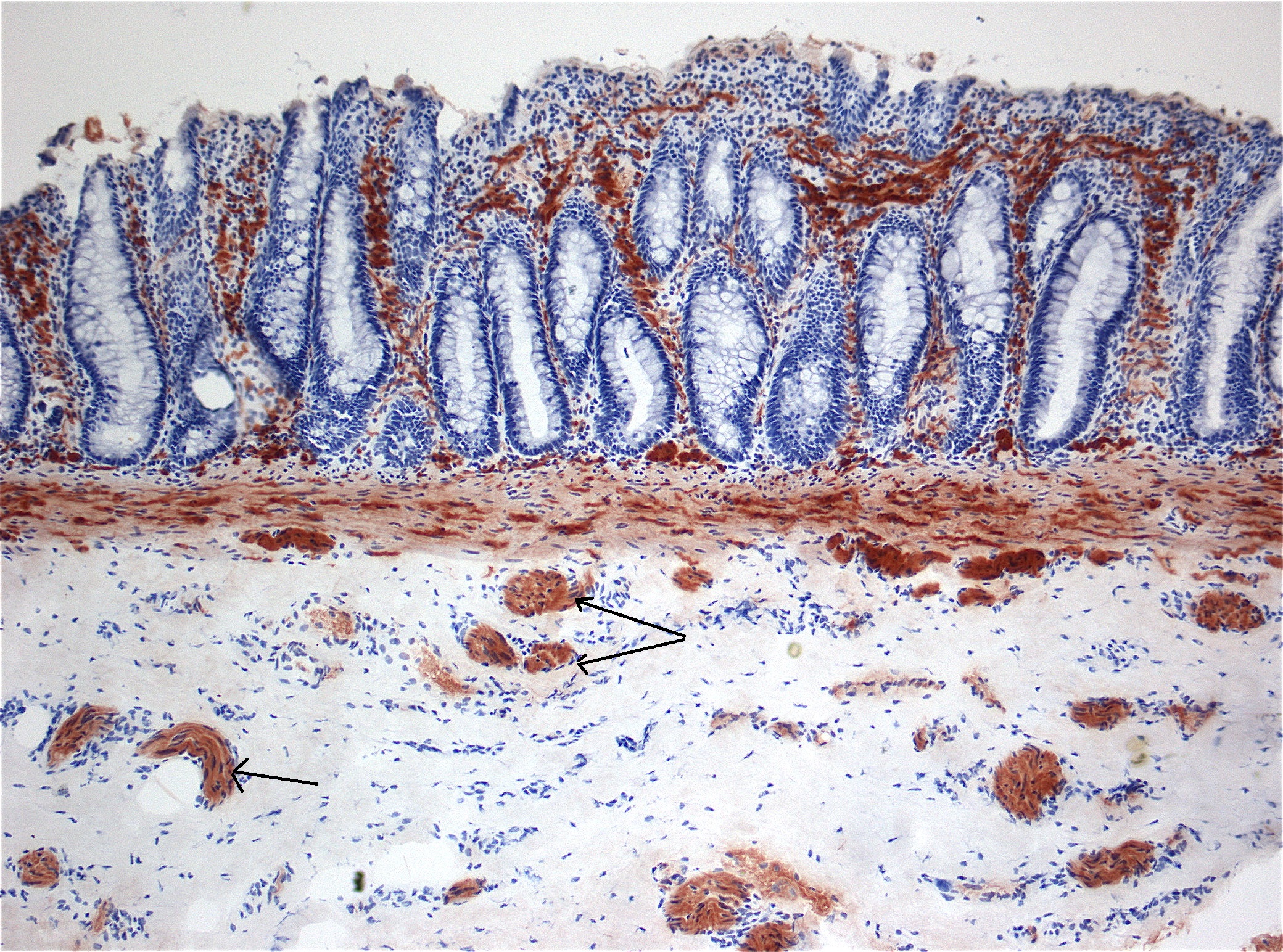Hirschsprung's disease pathophysiology
Jump to navigation
Jump to search
| https://https://www.youtube.com/watch?v=1pylBKNMcnw%7C350}} |
|
Hirschsprung's disease Microchapters |
|
Diagnosis |
|---|
|
Treatment |
|
Case Studies |
|
Hirschsprung's disease pathophysiology On the Web |
|
American Roentgen Ray Society Images of Hirschsprung's disease pathophysiology |
|
Risk calculators and risk factors for Hirschsprung's disease pathophysiology |
Editor-In-Chief: C. Michael Gibson, M.S., M.D. [2]; Associate Editor(s)-in-Chief: Ahmed Younes M.B.B.CH [3], Aditya Ganti M.B.B.S. [4]
Overview
Hirschsprung’s disease is a congenital disorder of the colon in which certain nerve cells, known as ganglion cells, are absent. It may cause chronic constipation.
Pathophysiology
Genetics
- According to a study in 2002 and more recent studies, the interaction between two proteins encoded by two variant genes may cause Hirschsprung’s disease.
- The RET proto-oncogene on chromosome 10 was identified as one of the involved genes; it was determined that dominant mutations may occur within this gene, leading to encoded protein function loss.[1]
- The protein that RET proto-oncogene has to interact to develop Hirschsprung’s disease, is termed EDNRB.
- EDRB protein encoded by the gene EDNRB located on chromosome 13.
- Six other genes were discovered to be associated with Hirschsprung’s disease. These genes include: GDNF on chromosome 5, EDN3 on chromosome 20, SOX10 on chromosome 22, ECE1 on chromosome 1, NTN on chromosome 19, and SIP1 on chromosome 2.
- Scientists concluded that the mode of inheritance in Hirschsprung’s disease is oligogenic. This means that two mutated genes interact to cause the disorder. Variations in RET and EDNRB have to coexist to involve a child with Hirschsprung’s disease.[2]
- Although six other genes show to have an effect on Hirschsprung’s disease, the exact interaction mechanism with RET and EDNRB is unknown. Thus, the specifics of the disease's origin are still not completely described.
- More recently, syndromic cases of Hirschprung's disease (i.e. cases associated with other defects of the autonomic nervous system) were shown to be caused by mutations in the homeobox gene PHOX2B.
- RET codes for the proteins that help neural crest cells (which become ganglion cells) move through the digestive tract during the development of the embryo.
- EDNRB codes for the proteins that connect these nerve cells to the digestive tract. This means that the absence of certain nerve fibers in the colon could be directly related to mutation of these two genes, which would lead to the wrong proteins being produced.
- Research in June 2004 suggested that there are actually ten genes associated with Hirschsprung’s disease. Also, new research suggests that mutations in genomic sequences involved in regulating EDNRB have a bigger impact on Hirschsprung’s disease than previously thought genes.
- RET mutates in different ways and is associated with Down syndrome. Since Down syndrome is co-morbid with two percent of Hirschsprung’s disease cases, it is assumed that RET is involved strongly in both Hirschsprung's disease and Down syndrome.
- RET is also associated with thyroid cancer and neuroblastoma. Both of these disorders have also been seen among Hirschsprung’s disease patients with greater frequency than general population.
- In the developing fetus, RET controls the neural crest cells traveling through the intestines. When RET mutations occur, the cells that started traveling through the colon, stop immigration and cause Hirschsprung’s disease. The earlier the RET mutation occurs in Hirschsprung’s disease, the more severe the disorder becomes.
- While researchers remain uncertain about the exact genetic cause of Hirschsprung’s disease, Dr. Sawin notes that in familial cases (in which families have multiple affected members), Hirschsprung’s disease exhibits autosomal dominant transmission, with dominance of the RET. However, in sporadic cases, Sawin notes that there is no identified inheritance pattern.[3][4][5][6]
Microscopic pathology
- Biopsy shows absence of ganglionic cells.
- Presence of hypertrophied nerve trunks in the lamina propria demonstrated by acetylcholinesterase staining.[7]
- Calretinin staining shows decreased immunofluorescence.
Video: Histopathological Findings
{{#ev:youtube|v3mfl0l6Tdo}}
References
- ↑ "Thieme E-Journals - European Journal of Pediatric Surgery / Abstract".
- ↑ "A gene for Hirschsprung disease (megacolon) in the pericentromeric region of human chromosome 10 - Nature Genetics".
- ↑ Elhalaby EA, Teitelbaum DH, Coran AG, Heidelberger KP (1995). "Enterocolitis associated with Hirschsprung's disease: a clinical histopathological correlative study". J. Pediatr. Surg. 30 (7): 1023–6, discussion 1026–7. PMID 7472925.
- ↑ Badner JA, Sieber WK, Garver KL, Chakravarti A (1990). "A genetic study of Hirschsprung disease". Am. J. Hum. Genet. 46 (3): 568–80. PMC 1683643. PMID 2309705.
- ↑ Amiel J, Sproat-Emison E, Garcia-Barcelo M, Lantieri F, Burzynski G, Borrego S, Pelet A, Arnold S, Miao X, Griseri P, Brooks AS, Antinolo G, de Pontual L, Clement-Ziza M, Munnich A, Kashuk C, West K, Wong KK, Lyonnet S, Chakravarti A, Tam PK, Ceccherini I, Hofstra RM, Fernandez R (2008). "Hirschsprung disease, associated syndromes and genetics: a review". J. Med. Genet. 45 (1): 1–14. doi:10.1136/jmg.2007.053959. PMID 17965226.
- ↑ Parisi MA, Kapur RP (2000). "Genetics of Hirschsprung disease". Curr. Opin. Pediatr. 12 (6): 610–7. PMID 11106284.
- ↑ Worman and Ganiats 1995, Am Fam Physician 51, 487-494 [1]
